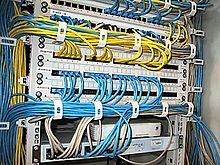Structured cabling
The Structured cabling referred to as universal building wiring (UGV) or universal communications cabling (UCT) is a concept for wiring with application-neutral communications cables in and between buildings.
Structured cabling is part of the property's infrastructure and is divided into primary, secondary and tertiary areas. The European Committee for Electrotechnical Standardization (CENELEC) has EN 50173 and EN 50174 for structured cabling . Internationally, the similar standard ISO / IEC 11801 is significant. Another standard for the structured cabling system is the North American standard TIA / EIA-568 . In Switzerland, the recommendation of the coordination conference of the building and real estate bodies of public developers applies.
Areas
Primary area
The primary area is the cabling between the buildings of a location and is also referred to as campus cabling or site cabling. The primary area comprises the cable from the site distributor to a building distributor, the building distributors and the cables between the building distributors.
Large cable lengths are necessary in the primary area. The fiber optic cable is therefore particularly suitable for a high data transmission rate because of the low attenuation . It also provides galvanic isolation , which is why equipotential bonding between the buildings is not absolutely necessary.
Inexpensive, but slower and more sensitive to interference is a connection to a cable with a twisted pair cable ( twisted pair ) with VDSL - modem .
Cable types used: fiber optic cable, twisted pair cable.
Maximum cable length:
- Fiber optic cable: 2,000 m
- Twisted pair cable with VDSL modems: 900 m (at 26 Mb / s)
Secondary education
The secondary area is the vertical floor cabling, i.e. the cabling between the floors of a building and is also referred to as climbing area cabling or building cabling. The secondary area comprises the cables from the building distributor to the floor distributors.
Cable types used: fiber optic cable, twisted pair cable.
Maximum cable length:
- Fiber optic cable: 2,000 m
- Twisted pair cable: 100 m
Tertiary education
The tertiary area is the horizontal floor cabling, i.e. the cabling within the floors of a building and is also referred to as floor cabling. The tertiary area comprises the cables from the floor distributor to the junction boxes.
Cable types used: fiber optic cable, twisted pair cable.
Maximum cable length:
- Fiber optic cable: 2,000 m
- Twisted pair cable: 100 m (90 m installation cable and 10 m patch cable provided)
elements
Distribution cabinets
Most distribution cabinets contain 19-inch racks in which suitable devices are installed. These are building and floor distributors (often designed as patch panels), but can also be hubs , switches and telephone systems .
Patch panels
Patch panels are patch panels (distributors) for which patch cables are used as patching.
Patch cord
Patch cables are used for patch panels as routing as well as for connecting end devices to junction boxes.
Junction boxes
Junction boxes with sockets according to RJ-45 , GG45 and TERA can be used.
electric wire
Fiber optic cables, coaxial cables and twisted pair cables can each be used as primary cables, secondary cables and tertiary cables.
literature
- BJ Hauser: Textbook of communication technology - introduction to communication and network technology for studies and vocational training. 2010, p. 44ff.
Web links
- Structured cabling , accessed November 5, 2017.
- Basics of computer networks , accessed on November 5, 2017.
Individual evidence
- ↑ DIN EN 50173 Information technology - application-neutral communication cable systems (December 2007)
- ↑ KBOB - Recommendation for universal communication cabling (UKV)
- ↑ a b c DIN EN 50173-1 Information technology - Application-neutral communication cable systems - Part 1: General requirements (December 2007)



